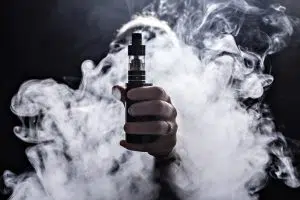
In recent years, there has been a sharp increase in the use of vaping and e-cigarettes, especially among young adults. While some people view this as a positive development – an alternative to smoking tobacco cigarettes – others are concerned about the potential health risks posed by these devices.
There is still a great deal of research to be done in this area, but there are some potential dangers that have been identified.
For example, the nicotine in e-cigarettes is highly addictive, and the long-term effects of exposure to this substance are not yet known. In addition, many e-cigarettes contain other harmful chemicals, including metals and carcinogens.
As more and more people turn to vaping and e-cigarettes, it is important to continue to monitor the situation closely and conduct additional research into the potential risks posed by these devices.
With a host of new players flooding onto the market, vape shops are cropping up all over the high street as people rush to cater to this new and growing market. However, making them work can be more difficult than you might imagine.
Why is vaping increasing
In recent years, vaping has become increasingly popular, especially among young people. While the exact reasons for this are not clear, there are a number of possible explanations.
First, vaping is often seen as a healthier alternative to smoking, as it does not involve inhaling tobacco smoke. Additionally, vaping can be less expensive than smoking, as e-cigarettes and other vaping devices do not require the purchase of tobacco products. Finally, some people may view vaping as a more socially acceptable form of smoking, as it does not produce an unpleasant odor or create secondhand smoke. Whatever the reasons for its popularity, vaping is now one of the most common forms of tobacco use in the United States.
The good news is that the market is definitely there. According to the World Health Organisation the number of smokers has been rising slowly since 2000. However, the number of vapers is growing at an exponential rate. Between 2011 and 2016, the number of vapers rose from seven million to 35 million, but that’s nothing compared with what’s to come. According to Euromonitor, the number of people vaping could rise to 55 million by 2021.
Such growth creates a fertile environment for new vaping businesses and shops, but there are concerns about how strong demand truly is and whether it is as safe as everyone thinks. Before we get into the opportunities of opening vape shops, therefore, we need to address a few questions about the market.
What are the main reasons why people choose to vape?
The main reasons people choose to vape is that vaping is a much healthier alternative to smoking cigarettes. Unlike cigarettes, which contain tobacco and other harmful chemicals, most e-cigarettes are filled with nicotine, propylene glycol, and flavorings. This means that there is no tar or carbon monoxide, two of the most harmful components of cigarettes.
In addition, vaping can be less expensive than smoking, as e-cigarettes can be reused multiple times. Some people also find that vaping is more convenient than smoking, as it can be done anywhere and does not produce an unpleasant smell. Overall, there are many reasons why people choose to vape instead of smoke cigarettes.
Is Vaping safe?
Evidence does suggest E cigarettes are healthier than smoking. While cigarettes burn tobacco, which produces tar and carbon monoxide, an E Cigarette has a small chamber which is filled with a liquid and heated to produce vapour. This vapour may or may not contain nicotine, but it doesn’t have all the unpleasant tar and carbon monoxide which makes cigarettes so harmful.
According to a report from Public Health England, E Cigarettes are 95% less harmful than smoking tobacco and that they are helping 20,000 people a year quit smoking. The agency suggests they should be prescribed on the NHS.
The benefits, therefore, are two-fold. On the one hand they do not produce tar or carbon monoxide, and they can also be used to ween people off nicotine. However, that doesn’t mean they are entirely safe.
The vapour does contain flavourings or additives as well asparticulates, oxidising agents and aldehydes all of which can affect the heart. A 2018 report from National Academies Press found that a single inhalation of an E cigarette sparked an increase in heart rate, and another study in the American Journal of Preventative Medicine suggested the daily use of vaping contributed to an increased risk of heart disease, even when other lifestyle factors had been taken into account.
However, this is a still new phenomenon and research is not conclusive. A 2019 study found no significant link between vaping and heart disease. So, there is uncertainty over exactly how harmful vaping might be. The only thing we can say for sure is that it’s a whole lot better than smoking.
Is vaping a new trend?
Vaping is not a new trend but in recent years, vaping has become an increasingly popular way to consume nicotine, especially among young people. Unlike traditional cigarettes, which burn tobacco and release harmful tar and chemicals into the lungs, vaping uses an electronic device to heat a liquid containing nicotine, propylene glycol, and flavorings.
The vapor that is produced is then inhaled. While some people argue that vaping is a healthier alternative to smoking, there is still limited research on the long-term effects of vaping.
In addition, because vaping is a relatively new phenomenon, we are only just beginning to understand its potential risks and benefits. Nevertheless, it is clear that vaping has quickly become a popular trends, especially among young people. Whether or not this trend will continue remains to be seen.
When did vaping become popular?
Vaping first became popular in the early 2000s, when e-cigarettes were introduced to the market. E-cigarettes were designed as an alternative to traditional cigarettes, and they quickly gained popularity due to their perceived health benefits.
In the years since, vaping has become increasingly popular, especially among young adults. Today, there is a wide variety of vaping devices available, ranging from simple disposables to more complex mods.
Vaping has also become a social activity, with many people using it as a way to bond with friends or relax after a long day. Whether you’re a seasoned vaper or just getting started, there’s no doubt that vaping has become a popular pastime for many people.
Regulatory change
Concern about the health impacts have led authorities to introduce laws on their use. The Welsh Government tried to introduce a ban on vaping in enclosed spaces although this legislation failed thanks to a row between Labour and Plaid Cymru.
In 2016 the Tobacco Products Directive (TPD) came into force which was designed to protect customers by limiting the amount of nicotine and the size of liquid refill containers and that the sale of E Cigarettes required retailers to notify the Medicines and Healthcare Products Regulatory Agency (MHRA)
These new laws have had all sorts of unintended consequences and make the business a little bit more difficult. Even so, there is no shortage of people wanting to get in on the act as we see from the rise of vape shops.
The affect of market regulation
But is regulation and policy the biggest stumbling block between e-cigarettes dominating the nicotine landscape and disappearing in a puff of its own vape?
In May, the Tobacco Products Directive will be reassessed by member states of the European Union to further regulate the production and sale of e-cigarettes across the continent. On the agenda includes new limitations on the size of e-liquid, a limit on the size of tanks/clearomisers, and nicotine strength being limited to 20mg to restrict potential nicotine poisoning. Perhaps the biggest regulation being tabled for the Tobacco Products Directive is prohibiting nicotine dosage, meaning that e-cigarettes will have to provide a consistent nicotine dose rather than dosage being dependant on the way the e-liquid is inhaled.
Though on paper these changes to regulation wouldn’t have any major impact on the overall e-cigarette industry, one cause for concern is a caveat that if a ‘competent authority’ such as a healthcare professional convinces three EU countries to ban an e-cigarette product – whether it’s a tank or a brand of e-liquid – on grounds of it being a potential health risk, then that product will have to be banned across the entire European Union. Scary stuff.
Rise of Vape shops
In 2015, when the first shops arrived, they were seen as an oddity, but they were soon popping up all over the place.
The barriers to entry were low and, for a small investment, almost anyone could get started. It sparked something of a gold rush and, no sooner had one vape shop opened in a street, than others joined it. According to the UK Vaping Industry Association, there are now 2,000 vaping outlets across the country rising to over 2500 in 2019.
Such has been the surge than there is concern about over saturation of the market. There are only a certain number of people who will ever be vaping and competition is also growing from tobacconists and ecommerce.
The web was where vaping first started to become big business and the leading vape sites, such as V2 Cigs, Vape Dinner Lady routinely attract more than a million visitors every month. As vaping goes mainstream, any shop which also sells cigarettes is getting in on the act. It’s easy to do and, since people will be shopping there in any case, they have a ready supply of customers.
That said, the rate at which the market is growing, and the nature of vaping itself, means there is still a reasonable opportunity for the specialist. Vaping has become much more than a healthy alternative to smoking; it has become a culture in itself. There are people who love vaping and want to spread the word, this lead to a rise in its use. There’s even healthy blogging community with people heading to social media to post pictures of themselves vaping.
For something which started as a way to stop people smoking it has managed something very surprising: it has become cool. Vaping comes in all shapes and sizes with different flavours and types of E Cigarettes. As with anything like this, then, there are several types of buyers; the casuals who just vape because they want to stop smoking and those who actively describe themselves as ‘vapers’, who see it as a lifestyle choice.
Conclusion
The rise in vape shops can be attributed to several factors, including the increasing popularity of vaping as a safer alternative to smoking, the growing variety of vape products available on the market, and the relatively low barriers to entry for starting a vape business. As more people seek out healthier options for satisfying their nicotine cravings, the demand for vaping products has increased, leading to the growth of vape shops.
Additionally, the variety of vape products, such as e-liquids and vaping devices, has expanded, creating a new market for small businesses to sell these items. As a result, the number of vape shops has grown, providing consumers with a wider range of options for purchasing vaping products.
Lee Jones is a seasoned Business Finance Specialist with over two decades of invaluable experience in the financial sector. With a keen eye for market trends and a passion for helping businesses thrive, Lee has become a trusted advisor to countless organizations seeking to navigate the complexities of finance.


